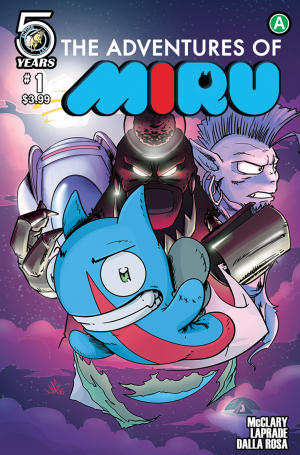Creating fantasy worlds can be a tricky tightrope to walk. Create something too wildly unusual and often you'll find yourself weighing your story down with pages of tedious exposition. An easy fix is often to use familiar public-domain elements of existing fantasy lore, mixing them around just enough to tell a new story. While sometimes helpful, this also results in fatigue of the predictable soup of dwarves, elves, and orcs culled from the oft-dredged Tolkien playbook. The Adventures of Miru takes a different route, creating a fantasy world from incongruous parts, casually mixing elements from a diverse swathe of genres in a fantasy environment that isn't unfathomably strange but certainly attempting to bypass the cookie cutter. And in a lot of ways, it works.
In a world living in the shadow of titanic magical history, the appearance of a small blue dragon sends portentous ripples through the land, drawing hero and villain alike to this mysterious creature. It's not a terribly rare story, hitting a lot of familiar notes along the way. However, this issue surpasses its familiarity in ways both broad and specific. The world is awkwardly put  together, but in a way that is surprisingly charming. Among the characters is a sentient mech suit with an abstractly unattractive Mickey Mouse-esque rat pilot and an antagonist that can be described as a patchwork teddy bear cyborg T-rex. It's a style that seems not as much reminiscent of any one comic tradition but rather of the platform adventure games of the late 90s and early 2000s, like Jak and Daxter and Conker's Bad Fur Day, that very special kind of creative jumble that had its own charisma despite itself. A lot of the charm of Miru to me was this approach to the world, one that wouldn't work for everyone, but struck enough of a balance between simplicity and still having rules that made me curious to stick around. The characters are decently written as well, with humor that works but without bashing you around with the same six 'personality lines' that these books seem to come prepackaged with.
together, but in a way that is surprisingly charming. Among the characters is a sentient mech suit with an abstractly unattractive Mickey Mouse-esque rat pilot and an antagonist that can be described as a patchwork teddy bear cyborg T-rex. It's a style that seems not as much reminiscent of any one comic tradition but rather of the platform adventure games of the late 90s and early 2000s, like Jak and Daxter and Conker's Bad Fur Day, that very special kind of creative jumble that had its own charisma despite itself. A lot of the charm of Miru to me was this approach to the world, one that wouldn't work for everyone, but struck enough of a balance between simplicity and still having rules that made me curious to stick around. The characters are decently written as well, with humor that works but without bashing you around with the same six 'personality lines' that these books seem to come prepackaged with.
The book visually is a mixed bag, but not a bad one. It has a style that feels like a webcomic rather than a polished studio ready style, but there is a confidence behind it that convinces you in what you're reading rather than drawing attention to the quality of technique. A key element that works towards its success is a strong color job, vibrant and with a varying pallet that improves the readability of the lines and strengthens tone.
I would look forward to reading more Miru. My one reservation is, like I had re-enforced with Aquaman this last week, it is very easy to start a story and much harder to maintain it. Miru's story is pretty familiar and while this issue reads well and seems to have some creativity to it, it could be a story that doesn't have anywhere interesting to go. However, as a single first issue, Miru is a good likable read with a pleasantly unconventional style. Fantasy is common because it is often easy to write because writers assume, like with horror, that it doesn't require anything more than applying the usual tropes. Because of this, it's rare I find new fantasy books I like, so consider me gratefully surprised that this one fits the bill. At the very least, you'll see me back for Issue #2.
[su_box title="Score: 3/5" style="glass" box_color="#8955ab" radius="6"]
[/su_box]
